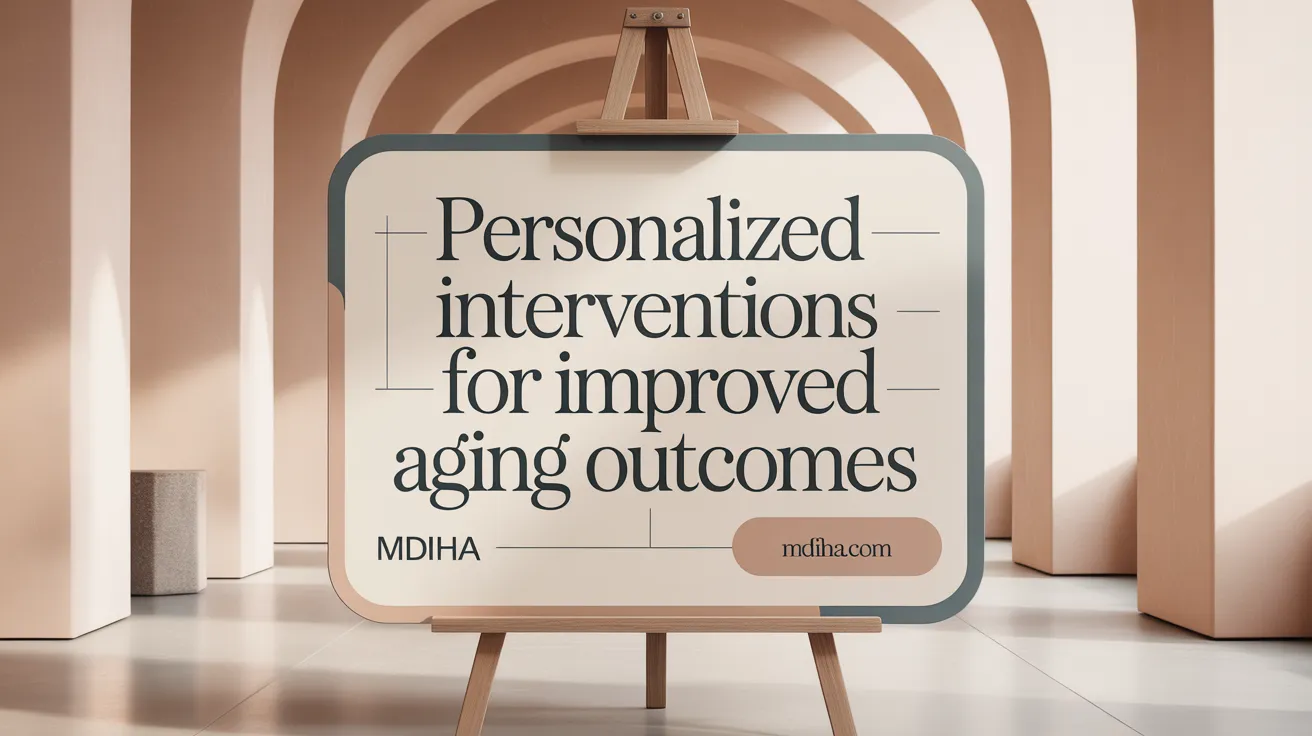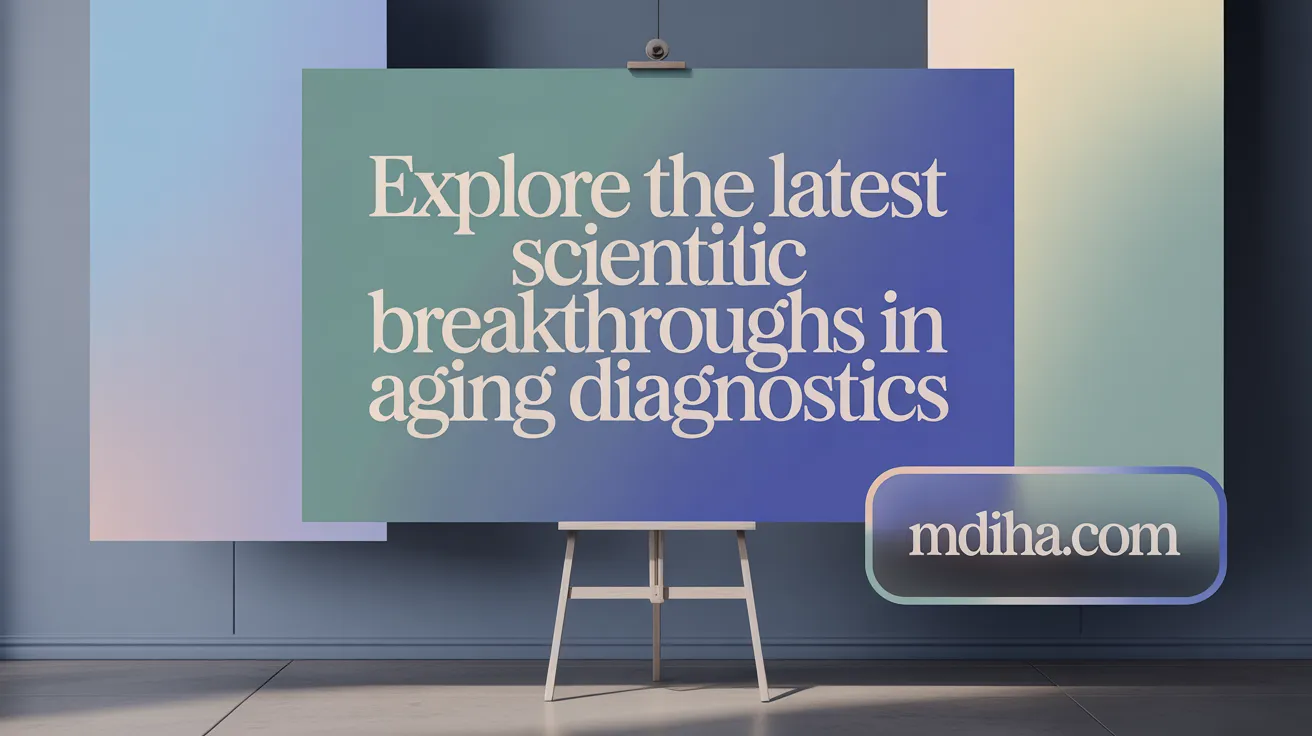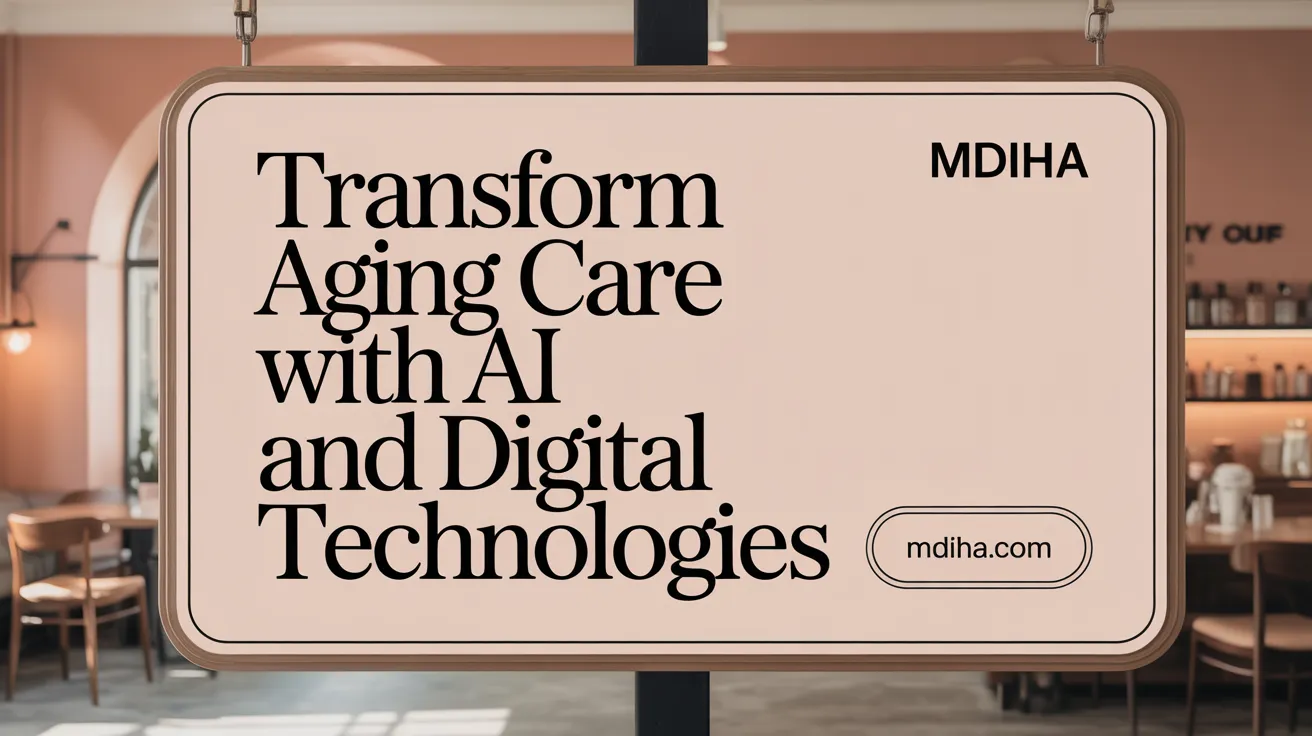The Imperative of Early and Precise Diagnostics in Aging
As populations worldwide continue to age rapidly, the burden of age-related diseases like dementia, cardiovascular disease, and cancer surges. Advanced diagnostics now stand at the forefront of transforming healthcare for older adults by enabling early detection and prevention tailored to individual biological aging processes. This article explores how cutting-edge diagnostic technologies, from molecular biomarkers to AI and wearable devices, are revolutionizing how we understand, detect, and combat age-related health risks to extend healthy lifespan and improve quality of life.
The Power of Early Detection: Transforming Age-Related Disease Management

What role do advanced diagnostic methods play in the early detection and prevention of age-related diseases?
Advanced diagnostic methods are vital for spotting biological changes and risk factors long before clinical symptoms appear. These techniques include sophisticated imaging like coronary artery calcium scoring and CT coronary angiography, which can detect early atherosclerosis more effectively than traditional risk calculators. Molecular assays and genetic testing, such as APOE genotyping and blood-based biomarkers like amyloid and tau (Alzheimer’s disease biomarkers), help identify predispositions to neurodegenerative diseases like Alzheimer’s. Additionally, AI-driven analytics and continuous health monitoring through wearables provide personalized insights that enable early interventions. This targeted approach allows healthcare providers to develop individualized strategies to prevent or delay disease onset, ultimately improving health outcomes and reducing healthcare costs.
How does early detection impact the management and progression delay of age-related diseases?
Detecting age-related diseases early allows for timely implementation of treatments and lifestyle changes that can slow or even prevent disease progression. For example, early identification of metabolic dysfunction through advanced lipid profiling and insulin sensitivity testing can lead to dietary and exercise interventions that reduce the risk of diabetes and cardiovascular disease. Similarly, detecting neurodegenerative risk factors early, such as cerebrovascular injury or amyloid accumulation, facilitates preventive measures like blood pressure control and cognitive engagement to delay dementia onset (NIA Alzheimer's research). While early detection provides significant benefits, it must be approached with age-specific considerations, as screening efficacy varies with age and patient health status (Primary Care Role in Early Detection). Overall, early intervention helps maintain quality of life and minimizes the severity of age-related conditions.
How are advanced diagnostics integrated into personalized prevention and healthcare strategies for aging individuals?
Personalized healthcare for aging individuals relies on integrating diverse diagnostic tools—genomics, biomarkers, imaging, and digital health sensors—to create a comprehensive health profile. Technologies like whole-body MRI, advanced blood tests, and wearable devices collect real-time data on physiological and molecular parameters. This information is analyzed using AI and machine learning models to predict individual risks and customize prevention plans. For example, biomarker panels can indicate inflammation levels or mitochondrial health (biomarkers of aging), guiding targeted nutritional or pharmacological interventions. Personalized strategies also consider genetic predispositions, such as APOE genotype, to optimize disease prevention. By combining these insights, clinicians can develop tailored health maintenance protocols, address potential vulnerabilities proactively, and extend the healthspan of aging populations.
Biological Age Testing and Biomarkers: Illuminating Individual Aging Trajectories
 Biological age testing is an advanced approach that estimates an individual’s internal physiological state, providing a more precise measure of aging than merely tracking chronological years. Unlike traditional age metrics, biological age reflects the functional integrity of cells and organs, thereby offering valuable insights into health status and susceptibility to age-related diseases (Biological age testing).
Biological age testing is an advanced approach that estimates an individual’s internal physiological state, providing a more precise measure of aging than merely tracking chronological years. Unlike traditional age metrics, biological age reflects the functional integrity of cells and organs, thereby offering valuable insights into health status and susceptibility to age-related diseases (Biological age testing).
A range of biomarkers play a critical role in assessing biological aging. These include inflammation markers such as C-reactive protein (CRP), which indicate systemic inflammation—an accelerant of cellular damage. Telomere length, a well-known indicator of cellular aging, shortens with each cell division and is associated with increased disease risk. Oxidative stress indicators reveal the balance—or imbalance—between free radical damage and antioxidant defenses, providing insight into cellular health. Additionally, genetic and epigenetic factors like DNA methylation patterns serve as molecular clocks, offering detailed maps of aging processes (Biomarkers of aging).
The integration of these biomarkers into clinical practice helps identify individuals at higher risk for conditions such as cardiovascular disease, neurodegeneration, and metabolic disorders. Molecular tools, including high-throughput sequencing and advanced imaging techniques like MRI and PET scans, allow detailed assessment of organ-specific aging. For example, brain imaging can detect early neurodegeneration, and cardiac MRI can reveal structural deterioration before clinical symptoms occur (Molecular mechanisms of aging). Physiological assessments such as grip strength and VO2 max further complement molecular data by measuring functional capacity (Early risk detection with Biograph).
Together, these biomarkers, imaging modalities, and molecular diagnostics create a comprehensive framework for understanding individual aging trajectories. This holistic insight enables personalized interventions—ranging from lifestyle modifications to targeted therapies—aimed at slowing or reversing organ decline. As research advances, these tools are expected to refine our capacity to predict health outcomes, guide preventative measures, and enhance quality of life throughout aging (Anti-Aging Prevention and Diagnostic Insights).
Advances in Aging and Disease Diagnostics: Scientific and Technological Breakthroughs
 Recent progress in aging and age-related disease diagnostics has been fueled by the discovery and validation of novel biomarkers and imaging techniques. Biomarkers such as flortaucipir and blood-based panels like PrecivityAD enable earlier detection of Alzheimer’s disease, with diagnostic accuracies exceeding 90%. These advances allow clinicians to identify neurodegenerative pathology during life, often before significant cognitive decline occurs.
Recent progress in aging and age-related disease diagnostics has been fueled by the discovery and validation of novel biomarkers and imaging techniques. Biomarkers such as flortaucipir and blood-based panels like PrecivityAD enable earlier detection of Alzheimer’s disease, with diagnostic accuracies exceeding 90%. These advances allow clinicians to identify neurodegenerative pathology during life, often before significant cognitive decline occurs.
Innovative testing procedures include sensitive neuroimaging modalities like PET scans for beta-amyloid and tau protein accumulation, as well as blood tests measuring plasma p-tau217 and other proteins linked to neurodegeneration. Emerging digital tools utilizing AI and wearable sensors facilitate functional assessment and continuous health monitoring, providing a noninvasive means to detect early disease signs.
Understanding the molecular mechanisms underlying aging reveals fundamental pathways involved in disease onset. These include genomic instability, telomere attrition, mitochondrial dysfunction, and epigenetic alterations. The accumulation of damaged proteins and systemic inflammation—referred to as “inflammaging”—exacerbates tissue deterioration and fosters conditions such as Alzheimer’s and cardiovascular diseases.
Recent research highlights the potential of targeting these molecular pathways through therapies that eliminate senescent cells, enhance autophagy, or modulate oxidative stress. Together, these technological and scientific advancements are paving the way for personalized diagnostics and interventions aimed at improving healthspan and delaying the onset of age-related diseases.
Artificial Intelligence and Digital Technologies in Aging Diagnostics

How are artificial intelligence and digital technologies applied in diagnosing age-related conditions?
Artificial intelligence (AI) plays a vital role in enhancing diagnostics for age-related diseases by analyzing large, complex datasets to identify early signatures of illness. Through machine learning algorithms, AI improves the accuracy of screening tools and detects subtle disease markers in medical imaging, genetic profiles, and biomarkers. For example, AI models can interpret MRI scans to identify early brain atrophy linked to cognitive decline, assist in categorizing subtypes of age-related macular degeneration from retinal images, and analyze blood biomarker patterns indicative of Alzheimer’s disease.
Digital health tools, including mobile applications, telehealth platforms, and continuous wearable sensors, facilitate real-time health monitoring, providing personalized insights and early warnings. These technologies support early intervention strategies that can delay or prevent disease progression, thereby extending health span and improving quality of life. Emerging AI applications also include assistive technologies that aid cognitive functions and foster social engagement, addressing mental health and independence in older adults (Artificial Intelligence for Healthy Aging, AI for Aging Innovation, Breakthrough AI technology for diagnosis, AI-powered software for early cognitive diagnosis).
How do wearable, remote monitoring, and IoT technologies contribute to health assessment in aging populations?
Wearable devices like fitness trackers, smartwatches, and specialized sensors continuously collect data on vital signs, physical activity, sleep patterns, and behavior, creating comprehensive health profiles. Internet of Things (IoT) systems connect these devices to healthcare providers, enabling remote monitoring that detects early signs of health issues such as arrhythmias, falls, sleep disturbances, or cognitive decline.
These technologies allow for unobtrusive, long-term health surveillance, making it possible to intervene preemptively before conditions worsen. For example, increased bathroom visit frequency detected by motion sensors can signal urinary tract infections, while changes in activity levels may indicate worsening neurodegenerative conditions like Parkinson’s or Alzheimer’s disease.
By interpreting sensor data through advanced analytics and machine learning, healthcare practitioners can identify risky trends, personalize treatment plans, and support aging individuals in maintaining independence. Despite challenges around privacy and user-friendliness, ongoing innovations aim to develop seamless and non-invasive systems that enhance preventive geriatric care, ultimately reducing hospitalizations and improving health outcomes (Wearable devices in elderly monitoring, Sensor-based early detection of age-related diseases, IoT in medical diagnosis, Sensor-based early detection at University of Bern).
Prognostic Models and Biomedical Technologies for Health Risk Management
Development of predictive models for elderly health monitoring
Recent advancements in predictive modeling incorporate machine learning algorithms like XGBoost and Random Forest, which analyze a variety of data types including clinical assessments, biochemical markers, and functional tests. These models can accurately predict outcomes such as mortality risk, likelihood of sarcopenia, and cognitive decline. For example, the Multidimensional Prognostic Index (MPI) synthesizes geriatric assessments to forecast multiple health outcomes, enabling clinicians to identify individuals at higher risk early on.
Such models utilize multimodal data, integrating imaging results, biomarker levels, and performance metrics like VO₂ max and grip strength to provide a comprehensive risk profile.
Biomedical approaches to assess and mitigate age-related health risks
Biomedical tools play a crucial role in early detection and intervention. They include advanced diagnostics like coronary artery calcium scoring and CT coronary angiography to detect subclinical atherosclerosis, and blood biomarker panels targeting inflammation, metabolic dysfunction, and neurodegeneration. For instance, biomarkers such as tau, amyloid-beta, GDF15, and microRNAs are used to gauge disease progression or risk.
Cognitive and sensory assessments help identify early neurodegenerative changes, while wearable sensors monitor movement patterns that may indicate frailty or risk of falls. These assessments inform tailored interventions, encompassing lifestyle modifications, pharmacological treatments, and emerging therapies like senolytics and NAD+ supplementation.
The use of AI and machine learning enhances these strategies by enabling continuous data monitoring and predictive analytics, supporting personalized treatment plans. Remote health monitoring technologies and assistive devices further promote independence and early intervention in aging populations.
Role of personalized medicine in aging care
Personalized medicine constitutes a transformative approach in aging care, focusing on customizing interventions based on individual genetic, biomarker, and functional profiles. Genetic testing, such as APOE genotyping, helps identify those at heightened risk for Alzheimer’s disease, allowing for targeted preventive measures.
Biological age testing, which evaluates cellular markers like telomere length, oxidative stress, and mitochondrial function, guides personalized lifestyle and treatment adjustments aimed at slowing biological aging.
Technologies such as epigenetic clocks, multi-omics profiling, and advanced imaging enable precise health risk stratification. This tailored approach ensures early and effective intervention, reduces overtreatment, and enhances quality of life.
Moreover, integrating digital health tools, wearable sensors, and AI-driven analytics facilitates ongoing personalized monitoring, empowering older adults to maintain health and independence longer.
As research continues to evolve, combining these biomedical and technological strategies promises to significantly improve aging outcomes, reduce disease burden, and extend healthspan.
Future Directions and Challenges in Advanced Diagnostics for Aging Populations
The field of advanced diagnostics for aging populations is rapidly evolving, with emerging trends focused on creating highly personalized and predictive healthcare solutions. Future strategies will likely incorporate integrated multi-omics data—including genomics, proteomics, and metabolomics—combined with advanced AI-driven analytics. These tools can analyze complex datasets to identify early signs of age-related diseases, such as cognitive decline, cardiovascular issues, and metabolic disorders, even before clinical symptoms appear (AI for Healthy Aging, Molecular diagnostics of ageing, Advanced diagnostics for age-associated diseases).
Telemedicine and remote monitoring technologies, exemplified by wearable sensors and IoT devices, will enable continuous health tracking outside clinical settings. This real-time data collection helps detect subtle changes in health, facilitating timely interventions and reducing hospitalizations (Wearable health monitoring devices, Sensor-based early detection of age-related diseases, IoT in medical diagnosis). Assistive innovations, including AI chatbots and personalized health coaching, will support social connectivity, mental health, and adherence to preventative strategies (AI for aging innovation).
Despite these promising developments, significant challenges remain. Data privacy and security are paramount, particularly when handling sensitive health information across digital platforms. Ensuring equitable access to these advanced technologies poses another critical issue, as disparities in socioeconomic status, geographic location, and technological literacy can widen health inequities. Moreover, underrepresented populations, including diverse ethnic and socioeconomic groups, must be included in research to develop scalable and effective diagnostics (Addressing AI bias in health diagnostics, Inclusive research and international collaboration).
To address these challenges, fostering inclusive research participation and international collaboration is essential. Shared datasets and cross-border partnerships can accelerate innovation, promote best practices, and help establish global standards. Ethical frameworks and regulatory policies must evolve to protect patient rights while facilitating technological advancement (Ethical frameworks and regulatory evolution, International collaboration in aging diagnostics).
In summary, the future of advanced diagnostics in aging care hinges on integrating cutting-edge technologies with ethical, inclusive approaches. Overcoming barriers related to privacy, equity, and diversity will be vital to designing scalable, effective tools that improve longevity and quality of life for all older adults (New vision for healthcare focuses on preventing aging-related diseases, Preventing age-related diseases through early detection).
Towards a Future of Proactive Aging Care
Advanced diagnostics are reshaping our approach to age-related diseases, moving healthcare from a reactive to a proactive paradigm. By harnessing biomarkers, imaging, AI, and digital technologies, clinicians can detect and address health risks long before symptoms arise. Personalized diagnostics support tailored interventions that extend healthspan and preserve quality of life. However, realizing this potential requires overcoming challenges related to access, privacy, and system integration. As research and technology continue to evolve, collaboration among scientists, clinicians, and policymakers will be vital to ensure that advanced diagnostics benefit all aging populations equitably, heralding a new era of healthy longevity.
